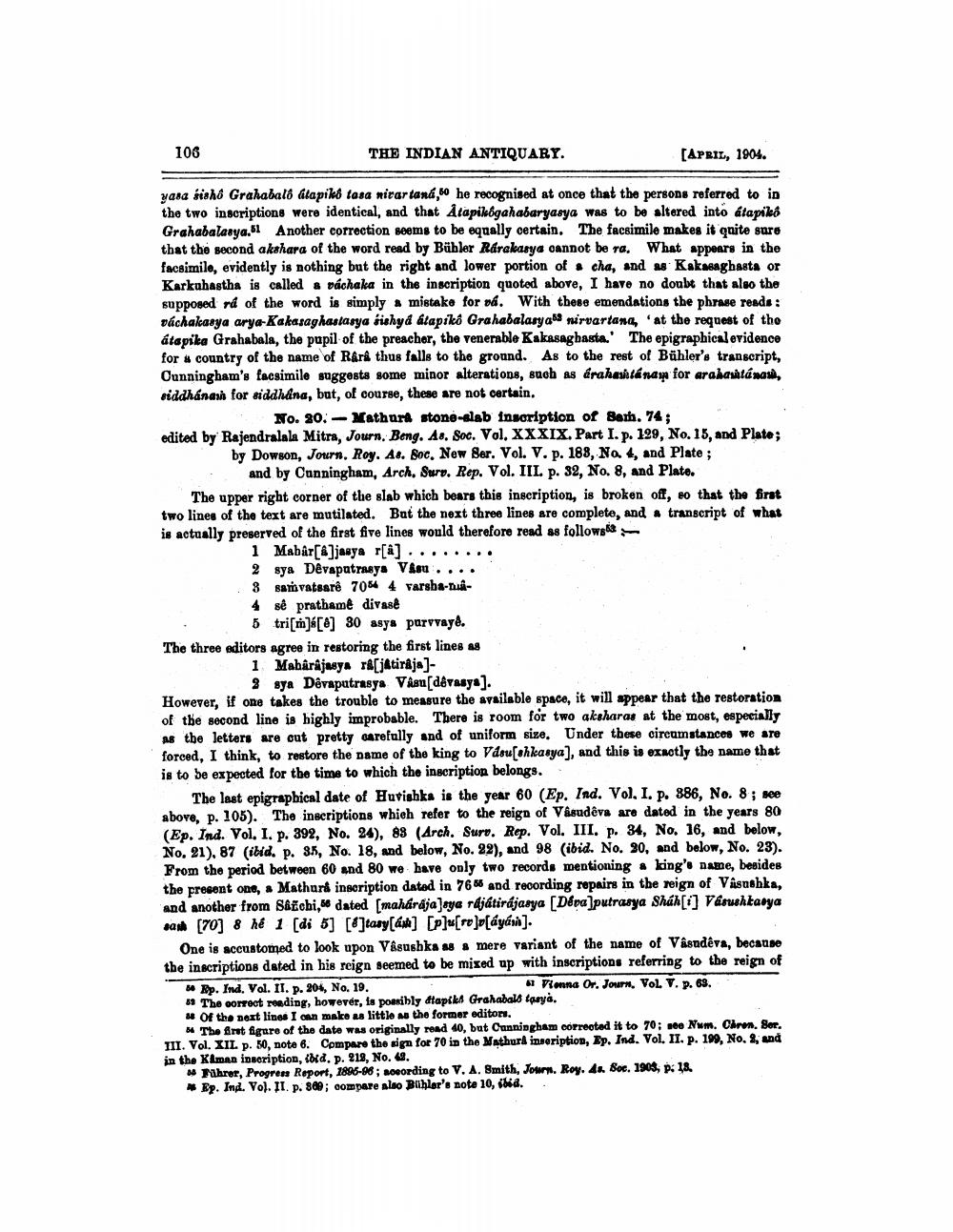________________
106
THE INDIAN ANTIQUARY.
[APRIL, 1904.
yasa sish Grahabald klapiks tasa nirar taná,60 he recognised at once that the persons referred to in the two inscriptions were identical, and that Atapikógahabaryasya was to be altered into áta piko Grahabalasya. Another correction seems to be equally certain. The facsimile makes it quite sure that the second akshara of the word read by Bühler Rárakasya cannot be ra. What appears in the facsimile, evidently is nothing but the right and lower portion of cha, and as Kakaaghasta or Karkahastha is called a váchaka in the inscription quoted above, I have no doubt that also the supposed nd of the word is simply a mistake for od. With these emendations the phrase reads: páchakasya arya-Kakasaghastasya fishyd atapiké Grahabalary and nirvartana, at the request of the átapika Grahabala, the pupil of the preacher, the venerable Kakasagbasta.' The epigraphical evidence for # country of the name of Rarî thus falls to the ground. As to the rest of Bühler's transcript, Cunningham's facsimile suggests some minor alterations, such as érahaténan for arahasiatánasil, siddhanash for siddhana, but, of course, these are not certain.
No. 80,- Mathurt stone-glab insoription of Sam. 74: edited by Rajendralala Mitra, Journ. Bong. As. Soc. Vol. XXXIX. Part I. p. 129, No. 15, and Plate;
by Dowson, Journ, Roy. As. Soc. New Ser. Vol. V. p. 188, No 4, and Plate ;
and by Cunningham, Arch. Suro, Rep. Vol. III. p. 32, No. 8, and Plato. The upper right corner of the slab which bears this inscription, is broken off, so that the first two lines of the text are mutilated. But the next three lines are complete, and a transcript of what is actually preserved of the first five lines would therefore read as follows
1 Mabar[6]jasya r[a] ...... 2 sya Devapatrasys Viru.... 8 samvatsarê 705 4 varsba-nu4 sê prathamē divase
0 tri[m][6] 30 asya puruvayê. The three editors agree in restoring the first lines as
1 Maharajasya re[jatirêja]
9 sya Dêvaputrasya Visu[dérasya]. However, if one takes the trouble to measure the available space, it will appear that the restoration of the second line is highly improbable. There is room for two akaharas at the most, especially As the letters are out pretty carefully and of uniform size. Under these circumstances we are forced, I think, to restore the name of the king to Vdouschkasya), and this is exactly the name that is to be expected for the time to which the inscription belongs.
The last epigraphical date of Huvishka is the year 60 (Ep. Ind. Vol. I. p. 886, No. 8; see above, p. 105). The inscriptions which refer to the reign of Vasudeva are dated in the years 80 (Ep. Ind. Vol. I. p. 392, No. 24), 88 (Arch. Suro. Rep. Vol. III. p. 34, No. 16, and below, No. 21), 87 (ibid. p. 85, No. 18, and below, No. 22), and 98 (ibid. No. 30, and below, No. 23). From the period between 60 and 80 we have only two records mentioning king's name, besides the present one, Mathara inscription dated in 76% and recording repairs in the reign of Visushka, and another from S&Echi, dated (mahardjajaya rdjátirájasya [Déra]putrasya Shah[] Varushkarya sa [70] 8 hé 1 [di 5] []tary[ánk] [P]-[ro]p[áyári).
One is accustomed to look upon Vésushka as a mere variant of the name of Vasudeva, because the inscriptions dated in his reign seemed to be mixed up with inscriptions referring to the reign of - Ap. Ind. Vol. II. p. 204, No. 19.
Vienna Or. Jours, Vol V. p. 69. ** The correct reading, however, is possibly dtapiks Grahabals tarya. # of the next lines I aun make a little as the former editon.
The Art figure of the date was originally read 40, but Cunningham corrected it to 70; so Num. Chron. Sor. III. Vol. XII. p. 50, note 6. Compare the sign for 70 in the Mathur inseription, Ep. Ind. Vol. II. p. 199, No. 2, and in the Kiman insoription, ibid. p. 218, No. . ^ Mihrer, Progress Report, 1895-98; According to V. A. Smith, Journ. Roy. 4. Soc. 1903, p. 18.
Ep. Ind. Vol. II. p. 869; compare also Bilhlor's note 10, 668.




